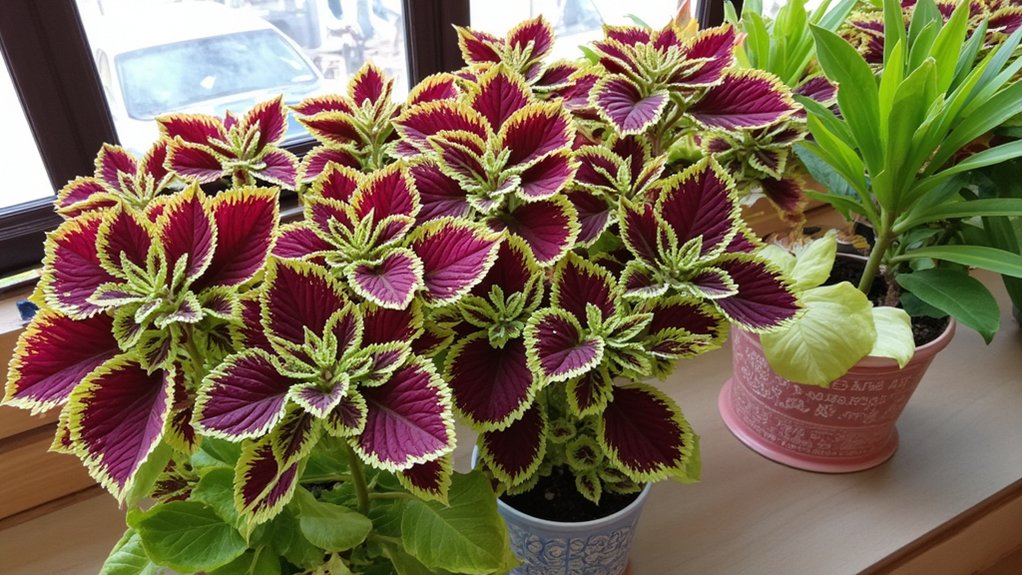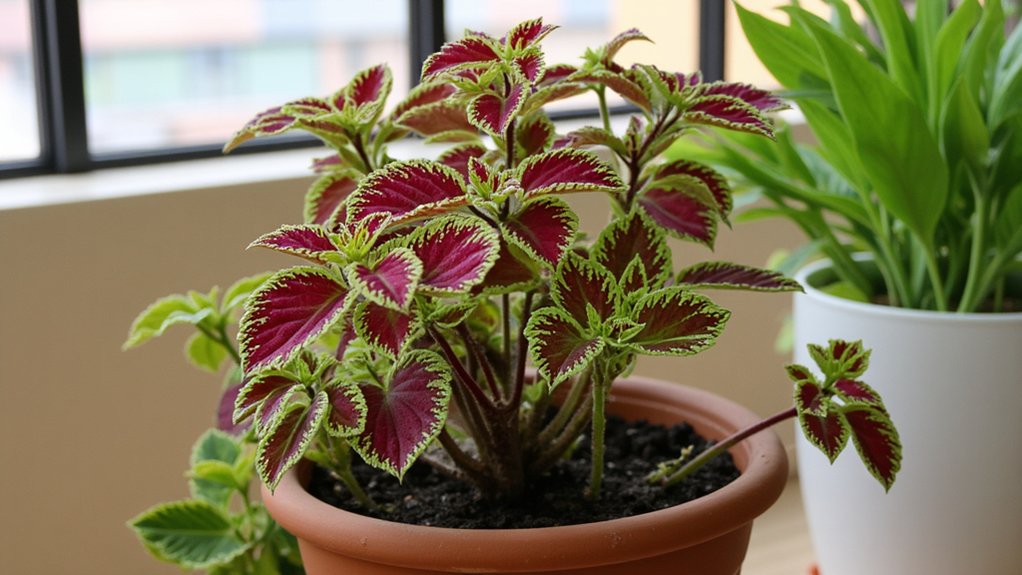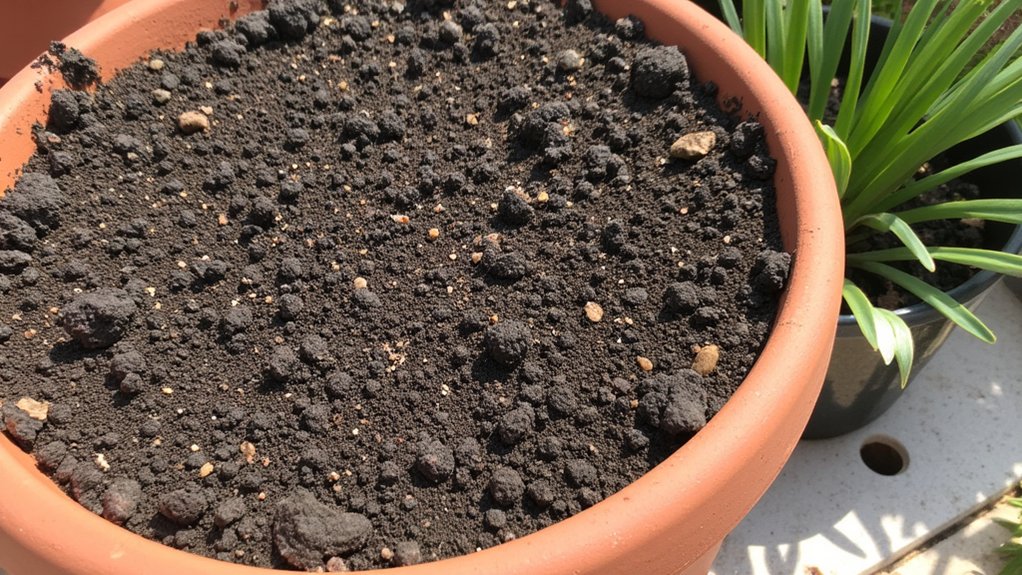Just like tending a vibrant living painting, caring for coleus indoors requires attention to specific details that’ll make your plants thrive. You’ll need to master the balance of light, water, and humidity while choosing the right varieties for your indoor space. Whether you’re drawn to their rich burgundy leaves or lime-green edges, these tropical beauties can transform any room into a colorful oasis – once you understand their essential care requirements.
Contents
- 1 Choosing the Right Coleus Varieties for Indoor Growing
- 2 Light Requirements and Placement
- 3 Watering Schedule and Soil Moisture
- 4 Temperature and Humidity Needs
- 5 Soil Type and Potting Requirements
- 6 Pruning and Maintenance Tips
- 7 Fertilizing Your Indoor Coleus
- 8 Pest Prevention and Treatment
- 9 Propagation Methods and Techniques
- 10 Common Growing Problems and Solutions
Choosing the Right Coleus Varieties for Indoor Growing

While coleus plants come in hundreds of varieties, not all of them thrive equally well indoors. You’ll have the best success with compact varieties like ‘Wizard Mix,’ ‘Kong,’ and ‘Premium Sun,’ which naturally maintain a bushy shape without extensive pruning.
Look for coleus varieties with vibrant, stable colors that won’t fade in lower light conditions. The ‘Black Dragon’ and ‘Chocolate Mint’ cultivars are excellent choices, as they’ll maintain their rich hues even away from direct sunlight.
For small spaces, consider dwarf varieties like ‘Fairway’ or ‘Mini Mixed,’ which typically stay under 12 inches tall and respond well to indoor conditions.
Light Requirements and Placement
Although coleus plants can tolerate various light conditions, they’ll thrive best in bright, indirect light for 4-6 hours daily. Place them 2-3 feet away from east or west-facing windows where they’ll receive filtered morning or afternoon sun. South-facing windows can work too, but you’ll need to diffuse intense light with a sheer curtain.
In darker spaces, you can supplement natural light with fluorescent grow lights positioned 12 inches above the plant’s canopy. Watch for signs of inadequate light, such as leggy growth or fading colors. If your coleus’s vibrant patterns start washing out, it’s getting too much direct sunlight.
Watering Schedule and Soil Moisture

Your coleus will need consistent moisture to maintain its lush foliage, but it doesn’t like to sit in waterlogged soil. Water thoroughly when the top inch of soil feels dry to the touch, typically every 3-4 days during growing season and less frequently in winter.
Insert your finger into the soil up to the first knuckle – if it’s dry at that depth, it’s time to water. When you do water, pour slowly until you see it emerging from the drainage holes, then empty the catch tray after 15 minutes.
Mist the leaves every few days if your home’s humidity falls below 50%, especially during heating season.
Temperature and Humidity Needs
Because coleus plants originate from tropical regions, they thrive in warm temperatures between 65-80°F (18-27°C) and prefer moderate to high humidity levels around 50-70%. You’ll want to keep them away from cold drafts, air conditioning vents, and windows during winter months.
To maintain proper humidity, you can place a humidity tray filled with pebbles and water beneath your plant, or use a small humidifier nearby. If you notice leaf edges turning brown or crispy, it’s often a sign that the air’s too dry. During winter, when indoor heating reduces humidity, you’ll need to mist your coleus every few days to compensate.
Soil Type and Potting Requirements

Proper soil and potting conditions play just as essential a role in indoor coleus care as the warm, humid environment these plants need. For best results, use a well-draining potting mix that’s rich in organic matter, combining two parts peat moss with one part perlite.
Choose a container that’s 1-2 inches larger than your plant’s root ball, ensuring it has drainage holes. You’ll want to repot your coleus annually in spring, as these fast-growing plants quickly outgrow their containers. When potting, position the plant at the same depth it was growing previously, and leave an inch of space below the rim for watering.
Pruning and Maintenance Tips
Regular pruning keeps coleus plants bushy and vibrant, with three key maintenance periods throughout the growing season. You’ll want to pinch back new growth in early spring, perform major pruning in mid-summer, and prepare for winter dormancy in late fall.
Start by removing the growing tips when stems reach 6 inches, pinching just above a leaf node. Don’t hesitate to cut back leggy branches by up to two-thirds their length, as coleus responds well to aggressive pruning. For flower removal, snip off buds as soon as they appear to maintain foliage vigor and prevent the plant from going to seed.
Fertilizing Your Indoor Coleus
Indoor coleus plants need three distinct feeding schedules throughout their growing season to maintain those striking leaf colors. During spring and summer, feed your plant every two weeks with a balanced, water-soluble fertilizer (10-10-10). In fall, reduce feeding to once monthly, using a lower nitrogen formula (5-10-10).
Stop fertilizing completely during winter months, as your coleus enters its semi-dormant phase. If you’re noticing pale leaves or stunted growth, you can supplement with a quick boost of liquid fertilizer, diluted to half-strength. Just don’t overdo it – too much fertilizer can cause leggy growth and dull foliage.
Pest Prevention and Treatment
While coleus plants aren’t major pest magnets, they can occasionally attract spider mites, mealybugs, and whiteflies – especially in dry indoor conditions. To prevent infestations, inspect your plant’s leaves weekly, focusing on the undersides where pests often hide.
If you spot pests, immediately isolate the affected plant and treat it with insecticidal soap or neem oil. Mix 2 tablespoons of solution per quart of water, then spray thoroughly, covering all leaf surfaces. For severe infestations, you’ll need to repeat this treatment every 7-10 days until the pests are gone.
Maintain good air circulation and avoid overwatering to discourage pest problems.
Propagation Methods and Techniques
Growing new coleus plants from existing ones lets you expand your collection without spending money on more plants. Stem cuttings are the easiest method – simply cut 4-6 inch sections just below a leaf node using clean, sharp scissors.
Remove the lower leaves and place your cuttings in water or moist potting soil. If using water, change it every few days to prevent bacterial growth. You’ll see roots develop within 2-3 weeks. Once roots reach 1-2 inches long, transplant water-rooted cuttings into soil.
For soil propagation, maintain consistent moisture and humidity by covering cuttings with a clear plastic dome or bag until new growth appears.
Common Growing Problems and Solutions
Even carefully tended coleus plants can develop issues, but most common problems have straightforward solutions. If you notice yellowing leaves, you’re likely overwatering – reduce frequency and guarantee proper drainage. Brown leaf edges typically indicate low humidity, so mist regularly or use a pebble tray.
Leggy growth means your plant needs more light. Move it closer to a window, but avoid direct sun that can scorch the leaves. For pest problems, inspect weekly for mealybugs and spider mites. If you spot them, wipe leaves with insecticidal soap and isolate the plant until they’re gone.
Watch for leaf drop in winter – it’s normal, but maintain temperatures above 60°F and reduce watering.
